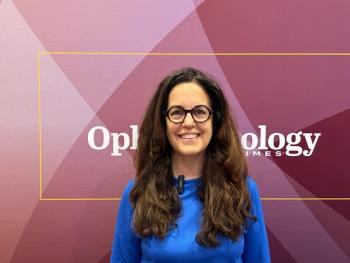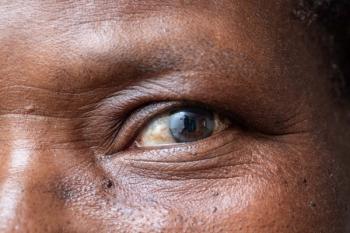
Keys to integrating, interpreting different types of OCT scans
Despite advances, imaging can only be complementary to clinician’s assessment
OCT imaging can prove to be a valuable tool for physicians going forward. The primary questions continue to be what each scan measures and how it can be used.
Reviewed by Lucy Q. Shen, MD
Ophthalmology has come a long way since the first
Literature on OCT has also increased, with more than 2,500 publications in the field of ophthalmology by 2015. But for the average clinician, both the new technological capabilities and the abundance of reading material could be obscuring the core questions: What does each OCT scan measure? How can it be used clinically? How can multiple scans be integrated, and are there any special considerations?
New parameter
A relatively new parameter is the BMO-MRW, the minimal rim width at Bruch’s membrane opening. This measurement does not depend on a reference plane because it measures the minimal distance between the internal limiting membrane and the termination of Bruch’s membrane, Dr. Shen explained.
“It measures a neuroretinal rim with an anatomically accurate border, which is the Bruch’s membrane opening,” she said.
This is different from the ONH parameters measured by the
There are other ONH parameters that do not depend on a reference plane. They are not commercially available at this time but have been well described in research work by several investigators. It is likely that these ONH parameters will become available to clinicians soon.
A study by Gmeiner et al.3 showed that BMOMRW measurements, along with RNFL thickness, are useful in differentiating preperimetric glaucoma from healthy controls.
RELATED:
In advanced glaucoma, a study by Belghith et al.4 showed that structural loss was best detected by ganglion cell scan rather than MRW or RNFL, while a paper by Lavinsky et al.5 found that MRW could still be useful in eyes with advanced RNFL loss.
When interpreting MRW measurements, Dr. Shen recommended looking closely for focal thinning on the scans, even when using automated software.
Her research group has found that focal thinning of BMO-MRW is associated with paracentral visual field loss.6 The RNFL thickness measurements, which are familiar to many ophthalmologists, are useful in preperimetric, mild, and moderate glaucoma for both diagnosis and structure-function correlation.
“We need to be aware of the floor effect in advanced glaucoma when the average RNFL thickness reaches 50-60 μm,” Dr. Shen cautioned. “At this point, RNFL thickness may not change even if the patient is still getting worse.”
In these cases, patients can be monitored with ganglion cell measurements of the macula instead of peripapillary RNFL.
Studies have suggested that this scan is useful to detect progression in advanced glaucoma and may have better diagnostic power than RNFL in eyes with paracentral visual field loss.
Ganglion cell scans have moderate diagnostic capability, comparable to that of RNFL, in preperimetric glaucoma, suggested by findings from a study by Rao et al.7
RELATED:
She added that she often obtains both RNFL and GCIPL scans and reviews them together. Integrating the different OCT scans sometimes yields better results than using only one technique.
Dr. Shen cited research that combining BMO-MRW and RNFL showed slightly better diagnostic power for preperimetric glaucoma than ether parameter alone. Wide-field RNFL thickness mapping, which includes both peripapillary and macular regions, has the potential to offer better sensitivity in detecting preperimetric and early glaucoma than RNFL and GCIPL.
Conclusion
Despite all of the advances in OCT technology, Dr. Shen cautioned that imaging can only be complementary to the clinician’s assessment of the
Dr. Shen used the example of a patient with multiple disc hemorrhages in the inferior optic nerve, while the OCT of the optic nerve head (BMO-MRW), peripapillary RNFL, and GCIPL were only demonstrating the existing structural damage to the superior part of the optic nerve and macula.
“As we are getting better images of optic nerve head, RNFL, and ganglion cells and learning to integrate and to see the big picture, we should not forget about the details which brought us here in the first place,” Dr. Shen said.
RELATED:
Disclosures:
Lucy Q. Shen, MD
P: 617/573-3569 E: [email protected]
This article is based on Dr. Shen’s presentation at the American Glaucoma Society 2019 annual meeting in San Francisco. Dr. Shen is a consultant for Topcon and has received research support from the company.
References:
1. Huang D, Swanson EA, Lin CP, et al. Optical coherence tomography. Science. 1991;254(5035):1178-1181.
2. Chen TC, Hoguet A, Junk AK, et al. Spectral-domain OCT: helping the clinician diagnose glaucoma: A report by the American Academy of Ophthalmology. Ophthalmology. 2018;125(11):1817-1827.
3. Gmeiner JM, Schrems WA, Mardin CY, Laemmer R, Kruse FE, Schrems-Hosel LM. Comparison of Bruch’s membrane opening minimum rim width and peripapillary retinal nerve fiber layer thickness in early glaucoma assessment. Invest Ophthalmol Vis Sci. 2016;57(9):575-584.
4. Belghith A, Medeiros FA, Bowd C, et al. Structural change can be detected in advanced glaucoma eyes. Invest Ophthalmol Vis Sci. 2016;57(9):511-518.
5. Lavinsky F, Wu M, Schulman JS, et al. Can macula and optic nerve head parameters detect glaucoma progression in eyes with advanced circumpapillary retinal nerve fiber layer damage? Ophthalmology. 2018;125:1907-1912.
6. Taniguchi EV, Woodward AM, Magnelli P, et al. Thin minimal rim width at Bruch’s membrane opening is associated with glaucomatous paracentral visual field loss. Clin Ophthalmology. 2017;11:2157-2167.
7. Nakanishi H, Akagi T, Hangai M, et al. Sensitivity and specificity for detecting early glaucoma in eyes with high myopia from normative database of macular ganglion cell complex thickness obtained from normal non-myopic or highly myopic Asian eyes. Graefes Arch Clin Exp Ophthalmol. 2015;253(7):1143-1152.
8. Rao HL, Addepalli UK, Chaudhary S, et al. Ability of different scanning protocols of spectral domain optical coherence tomography to diagnose preperimetric glaucoma. Invest Ophthalmol Vis Sci. 2013;54(12):7252- 7257.
9. Raza AS, Cho J, de Moraes CG, et al. Retinal ganglion cell layer thickness and local visual field sensitivity in glaucoma. Arch Ophthalmol. 2011129(12):1529-1536.
Newsletter
Don’t miss out—get Ophthalmology Times updates on the latest clinical advancements and expert interviews, straight to your inbox.



















































.png)


